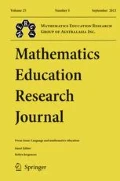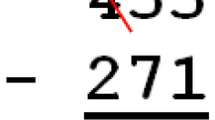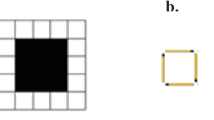Abstract
This paper considers the experiences of two sets of students who attended schools that taught mathematics in completely different ways. One of the schools used a traditional, textbook approach, and the other used an open, project-based approach. The latter approach produced equity between girls and boys whereas the textbook approach prompted many of the girls to under achieve. This paper will consider the experiences of girls and boys who followed the project-based approach, reflect upon the sources of equity within this approach and relate the differences between the two approaches to Gilligan’s notions of “separate” and “connected” knowing.
Similar content being viewed by others
References
Assessment of Performance Unit [APU] (1980a).Mathematical development primary survey report no 1, January. London: Her Majesty’s Stationery Office.
Assessment of Performance Unit [APU] (1980b).Mathematical development secondary survey report no 1, September. London: Her Majesty’s Stationery Office.
Askew, M., & Wiliam, D., (1995).A review of recent research in mathematics education. London: Her Majesty’s Stationery Office.
Barber, M (1994, August 23). Report into school students’ attitudes.The Guardian, p. 2.
Belencky, M. F., Clinchy, B. M., Goldberger, N. R., & Tarule, J. M. (1986).Women’s ways of knowing: The development of self, voice and mind. New York: Basic Books Inc.
Bleach, K. (1996). Boys will be boys-but will they be successful?All-in -Success, 7(2), 17–19.
Boaler, J. (1997a, February).Mathematical equity—underachieving boys or sacrificial girls? Paper presented at the “Are Boys Underachieving?” Seminar Series. London Institute of Education.
Boaler, J. (1997b).Experiencing school mathematics: Teaching styles, sex and setting. Buckingham: Open University Press.
Boaler, J. (1997c). Reclaiming school mathematics: The girls fight back.Gender and Education, 9(3), 285–306.
Boaler, J. (1997d). When even the winners are losers: Evaluating the experiences of “top set” students,Journal of Curriculum Studies, 29(2), 165–182.
Boaler, J. (in press). Open and closed mathematics approaches: Student experiences and understandings.Journal for Research in Mathematics Education.
Burton, L. (1986). Femmes et Mathematiques: Y a-t-il une intersection? In L. Lafortune (Ed.),Femmes et mathematiques (pp. 19–55). Montreal: Les Iditions du Remu-menage.
Burton, L. (1995). Moving towards a feminist epistemology of mathematics. In P. Rogers & G. Kaiser (Eds.),Equity in mathematics education: Influences of feminism and culture (pp. 209–226). London: Falmer Press.
Elwood, J., & Comber, C. (1996).Gender differences in examinations at 18+: Final report. London: Institute of Education.
Forgasz, H. J., & Leder, G. C. (1996). Mathematics classrooms, gender and affect.Mathematics Education Research Journal, 8(2), 153–173.
Friedman, L. (1995). Assisting women to complete graduate degrees. In P. Rogers & G. Kaiser (Eds.),Equity in mathematics education (pp. 49–58). London: Falmer Press.
Gilligan, C. (1982).In a different voice: Psychological theory and women’s development. Cambridge, MAS: Harvard University Press.
Glaser, B. G., & Strauss, A. L. (1967).The discovery of grounded theory: strategies for qualitative research. New York: Aldine Publishing Company.
Huberman, A. M., & Crandall, D. P. (1982). Fitting words to numbers.American Behavioural Scientist, 26(1), 62–83.
Keedy, J., & Drmacich, D. (1994). The collaborative curriculum at the school without walls: Empowering students for classroom learning.The Urban Review, 26(2), 121–135.
Koehler, M. S. (1993). Classrooms, teachers and gender differences in mathematics. In E. Fennema & G. C. Leder (Eds.),Mathematics and gender (pp. 128–148). Brisbane: Queensland University Press.
Leder, G. C. (1993). Teacher/student interactions in the mathematics classroom: A different perspective. In E. Fennema & G. C. Leder (Eds.),Mathematics and gender (pp. 149–168). Brisbane: Queensland University Press.
Leder, G. & Forgasz, H. (1992). Gender: A critical variable in mathematics education. In B. Atweh & J. Watson (Eds.),Research in mathematics education in Australasia 1988–1991 (pp. 67–95). Brisbane: Mathematics Education Research Group of Australasia.
Maher, C. (1991). Is dealing with mathematics as a thoughtful subject compatible with maintaining satisfactory test scores? A nine-year study.Journal of Mathematical Behaviour, 10, 225–248.
Murphy, P. (1990). Assessment and gender.Cambridge Journal of Education, 21(2), 203–214.
Office of Population Censuses & Surveys. (1980).Classification of occupations 1980. London: Her Majesty’s Stationery Office.
Office for Standards in Education. (1994).Mathematics key stages 1, 2, 3 and 4. London: Her Majesty’s Stationery Office.
Resnick, L. (1990). From protoquantities to number sense. In G. Booker, P. Cobb & M. T. Mendicuti (Eds.),Proceedings of the Fourteenth International Conference for the Psychology of Mathematics Education (pp. 305–311). Mexico: PME.
Rossi Becker, J. R. (1995). Women’s ways of knowing in mathematics. In P. Rogers & G. Kaiser (Eds.),Equity in mathematics education: Influences of feminism and culture (pp. 163- 174). London: Falmer Press.
Sigurdson, S., & Olson, A. (1992). Teaching mathematics with meaning.Journal of Mathematical Behaviour, 11, 37–57.
Spender, D. (1982).Invisible women: The schooling scandal. London: Women’s Press.
Strauss, A. L. (1987).Qualitative analysis for social scientists. Cambridge: Cambridge University Press.
Weiner, G., Arnot, M., &. David, M. (1996).Is the future female?Female success, male disadvantage and changing gender patterns in education. Paper presented at the “Are boys underachieving?” seminar series. London Institute of Education, 17 May.
Waiden, R. & Walkerdine, V. (1985).Girls and mathematics: from primary to secondary schooling. London: University of London Institute of Education.
Walkerdine, V., & Girls and Mathematics Unit (Eds.). (1989).Counting girls out. London, UK: Virago.
Author information
Authors and Affiliations
Rights and permissions
About this article
Cite this article
Boaler, J. Equity, empowerment and different ways of knowing. Math Ed Res J 9, 325–342 (1997). https://doi.org/10.1007/BF03217322
Issue Date:
DOI: https://doi.org/10.1007/BF03217322




